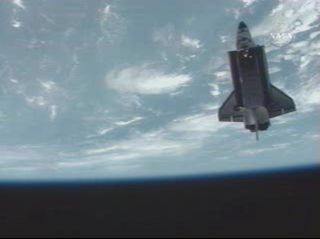NASA Clears Space Shuttle Atlantis for Thursday Landing

This storywas updated at 8:17 p.m. EDT.
CAPECANAVERAL, Fla. -- NASA mission managers cleared the space shuttle Atlantis andits seven-astronaut crew for a planned Thursday landing after resolving twofinal issues.
LateWednesday, engineers completed studies into a small bit of fluff poking outfrom heat shield panels near the tip Atlantis? left wing and new data relatedto the shuttle?s torn engine pod blanket repaired during the shuttle?s STS-117flight. Neither item was thought to be of major concern, but NASA officialsopted to clear them just the same, the space agency said.
?We?re justgoing to review those two. I think we?re going to stomp them flat,? said JohnShannon, NASA?s deputy shuttle program manager, late Wednesday. ?And then we?regoing to be done with it and we?ll be ready to come home.?
Atlantisand its STS-117 astronaut crew are due to land on a runway here at NASA?sKennedy Space Center (KSC) Thursday at 1:55 p.m. EDT (1755 GMT), thoughanticipated thunderstorms and thick clouds near the landing strip may preemptthe orbiter?s Earth return, mission managers said.
?I know theforecast right now is no go, but clearly weather changes,? said Norm Knight,NASA?s ascent and entry flight director for the shuttle flight, during theafternoon briefing. ?As we get closer, we?ll get a better handle on theforecast models.?
Commandedby veteran shuttle flyer Rick Sturckow, Atlantis? seven STS-117 astronauts arewrapping up a 13-day mission that delivered a pair of new starboardsolar arrays, trusses and one new crewmember to the International SpaceStation. The mission included four spacewalks to install the new massivegirders and solar wings, as well as to furl an older solar array atop thestation and stapledown a loose thermal blanket on Atlantis? left aft engine pod.
Get the Space.com Newsletter
Breaking space news, the latest updates on rocket launches, skywatching events and more!
During thatblanket repair, engineers found that its underlying layer did not match thoseused in launch heating simulations, leading some to believe the area might havebeen subjected to ascent temperatures just slightly higher than thosepredicted. The mistake, while late-breaking, posed no risk to Atlantis or itscrew, mission managers said.
?Theengineering and safety teams believe it?s absolutely no risk at all toreentry,? Shannon said.
The bit ofleft wing fluff, actually a piece of frayed filler material, was seen during a secondheat shield inspection of Atlantis by its astronaut crew using asensor-laden extension of the orbiter?s robotic arm.
The survey,known as a late inspection, found no signs of damage from micrometeorites ororbital debris. Late inspections are now standard to all shuttle missionsfollowing the loss of seven astronauts and the shuttle Columbia in 2003.
After alate Wednesday meeting, mission managers cleared both issues to set the stagefor Thursday?s planned landing.
?Thepolling was unanimous on both issues,? NASA spokesperson Allard Beutel told SPACE.comof the positive decision. ?We?re clear to land at the Kennedy Space Center,weather permitting.?
Floridalanding preferred
Atlantishas enough supplies to stay in orbit until Sunday, though mission managers planto land the shuttle by Saturday and keep the final day in reserve in case of anunexpected malfunction.
The weekendlanding opportunities are largely due to the power conservation efforts by the Atlantiscrew during their flight, when NASA managers were considering extending themission a day or so toaid computer issues - since resolved - aboard the ISS.
?It?s definitelya luxury,? Knight said of the extra landing opportunities. ?Clearly we usethose judiciously and we don?t treat them lightly.?
Knight saidAtlantis will attempt to land at KSC during two Thursday opportunities - the firstat 1:55 p.m. EDT and the second at 2:30 p.m. EDT (1830 GMT). If weatherintervenes, the shuttle will wave off until Friday.
The spaceagency?s backup landing strip at Edwards Air Force Base in California will becalled up in addition to KSC for any Friday or Saturday landing attempts, headded.
NASAprefers to land space shuttles at KSC because it is home to the orbiter?shangars and launch sites. It allows for a faster turnaround to prime eachorbiter for its next launch. Atlantis? next flight, aimed at hauling theEuropean Space Agency?s Columbus laboratory to the ISS, is slated to liftoff inDecember.
Landings atEdwards Air Force Base, where orbiters are met by engineers at NASA?s DrydenFlight Research Center and ferried back to KSC atop a modified 747 jet,typically add about one extra week and a cost of $1 million to a shuttle?sturnaround time.
NASA isbroadcasting the space shuttle Atlantis' STS-117 mission live on NASA TV. Click here for mission updates andSPACE.com'svideo feed.
- SPACE.com Video Interplayer: Space Station Power Up with STS-117
- IMAGES: Atlantis Shuttle?s STS-117 Launch Day
- Complete Shuttle Mission Coverage
Join our Space Forums to keep talking space on the latest missions, night sky and more! And if you have a news tip, correction or comment, let us know at: community@space.com.

Tariq is the Editor-in-Chief of Space.com and joined the team in 2001, first as an intern and staff writer, and later as an editor. He covers human spaceflight, exploration and space science, as well as skywatching and entertainment. He became Space.com's Managing Editor in 2009 and Editor-in-Chief in 2019. Before joining Space.com, Tariq was a staff reporter for The Los Angeles Times covering education and city beats in La Habra, Fullerton and Huntington Beach. In October 2022, Tariq received the Harry Kolcum Award for excellence in space reporting from the National Space Club Florida Committee. He is also an Eagle Scout (yes, he has the Space Exploration merit badge) and went to Space Camp four times as a kid and a fifth time as an adult. He has journalism degrees from the University of Southern California and New York University. You can find Tariq at Space.com and as the co-host to the This Week In Space podcast with space historian Rod Pyle on the TWiT network. To see his latest project, you can follow Tariq on Twitter @tariqjmalik.
